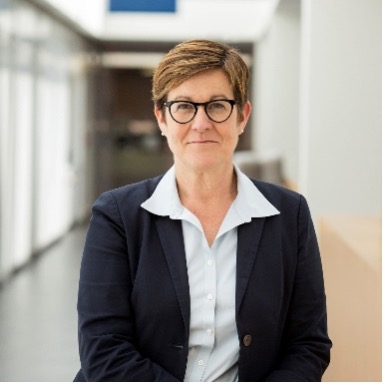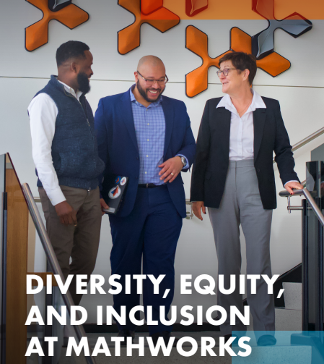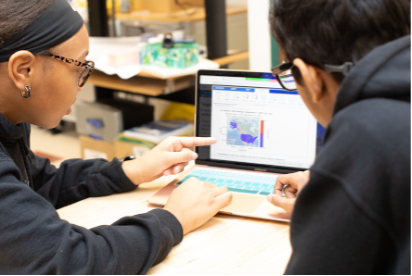ASEE CDEI Scholar Spotlight Series: P.J. Boardman
P.J. Boardman
P.J. Boardman is the Global Director of STEM Outreach and Workforce Development at MathWorks managing a team responsible for catalyzing, engaging, and inspiring the next generation of scientists and engineers to bridge the STEM gap and prepare the workforce of tomorrow. PJ’s team identifies, initiates, and supports scalable programs to connect students and educators with training, content, and technology to advance their STEM initiatives. She is on the Executive Committee, Board of Directors, of the American Society for Engineering Education Chair of (ASEE) and the VP of Institutional Councils. She is the Chair of the ASEE Corporate Member Council (CMC) and the liaison for the P12 Commission as well as a member of the Executive Committee for the Global Engineering Dean’s Council (GEDC). Prior to joining MathWorks in 2014, P.J. was a Vice President of Cengage Learning and Pearson Education. P.J. has a B.A. in Mathematics from the College of the Holy Cross and an MEd from the University of Massachusetts with a focus on Instructional Design and Online Learning. She is a Rotary International Ambassadorial Scholar where she attended the Universidad de Santiago, Santiago de Compostela, Spain.
 Tell us your story of belongingness (e.g., within engineering discipline, within ASEE, within your industry, your community, etc.).
Tell us your story of belongingness (e.g., within engineering discipline, within ASEE, within your industry, your community, etc.).
I grew up as the ninth child in a family of 10 and was raised to believe that with the right education and hard work, you can do whatever you want to do and be whoever you want to be. From an early age, I was encouraged to pursue mathematics by my family and my teachers so I am grateful that I was never told as a young girl “you can’t do math.” Due to my family values and wanting to keep up with my older siblings (which was no small feat!), to belong and succeed at a younger age, I leaned into working towards excelling in school, sports, and my extra-curricular activities.
As I continued in my education and early career, I found community and belonging with people who shared my values and who accepted me. Later in my life, as a working mom, at times it was more challenging to feel like I belonged as I advanced up the corporate ladder where there were fewer women in senior leadership and c-suites. Juggling work, family, travel, and keeping the right balance is complicated and challenging. As I advanced in my career, I looked for coaches, mentors, colleagues, and friends who have kept me grounded in my values and helped me to succeed and belong. I am grateful for those many coaches in my journey as well as my amazing family that has been my north star with a very supportive husband, two daughters, and my very large extended family.
Describe your understanding of DEI and why it is essential to what you do.
Today, in my role at MathWorks, my team is dedicated to catalyzing, engaging, and inspiring the next generation of scientists and engineers and to bridge the STEM gap. As one of MathWorks 3 Pillars for Diversity, Equity, and Inclusion which span STEM Outreach, Recruiting, and Staff Experience, we focus on outreach with the community to ignite interest in STEM.
More than ever, the work we do in DEI is critical in the community and for my role at MathWorks. At MathWorks we believe that:
– To innovate in engineering and science, diverse perspectives are critical. They help us challenge the status quo and arrive at better solutions. Research shows that teams are most creative and successful when they include people who think differently from one another.
– MathWorks has a values-based culture, including the core value of doing the right thing. We know that we derive as much strength from our differences as we do our similarities and we want to make sure every voice is heard and welcome.
– There is a gap in STEM talent from underrepresented communities today. MathWorks is actively working to close this STEM gap by investing its resources in programs designed to break down the barriers and catalyze the interest, access, and success of underrepresented communities in STEM careers.
Learn more about MathWorks commitment to DEI here: Diversity, Equity, and Inclusion (DEI) at MathWorks – MATLAB & Simulink
At MathWorks, I am fortunate to have great colleagues across the world who work together to build a culture of belonging with our core MathWorks values of communication, collaboration, and “doing the right thing”. We have affinity groups designed to facilitate inclusion including: Women at MathWorks, Black Excellence, SOMOS (Latine/Latinx), LGBTQ+ and Neurodiverse affinity groups. Over time, I have learned that, if you are authentic and let others around you be authentic, you create a culture of belonging that enables colleagues to bring their true selves to work
Briefly explain the current initiatives that you are doing towards DEI.
As part of our commitment to Diversity, Equity, and Inclusion (DEI), our team is actively engaged in supporting STEM outreach initiatives and in opening access to MATLAB and Simulink. Our goal is to provide students from diverse backgrounds with access to industry-standard software tools, empowering them to pursue careers as engineers and scientists. By making these resources available, we aim to bridge the gap in STEM education and ensure that all students, regardless of their background, have the opportunity to develop the skills necessary for success in the field. Our efforts include workshops, training sessions, and collaborative projects that not only enhance technical proficiency but also foster an inclusive learning environment.
Some examples of initiatives we are working on include:
– AI STEM Camps across different regions of Florida in collaboration with Univ of Florida
– Collaborating and sponsoring curriculum projects designed to democratize Engineering education and open access to Engineering for everyone:
-e4usa: Engineering for Us All which is a high school program in development for Engineering Problem Solving and Programming with MATLAB
-YES: Youth Engineering Solutions designed for middle school engineering and computer sciences courses available with free interactive examples with MATLAB. See examples here: K-12 Computational Thinking Live Scripts – MATLAB & Simulink (mathworks.com)
-MIRROR- Olin College initiative which is a “Movement in Reciprocity and Reimagining Outreach Relationships” which has a space in Kendall Square, Cambridge, that will develop STEM engagement opportunities and community partnerships for underserved local youth NEWS: MathWorks provides funding for the Olin MIRROR | Olin College of Engineering
-RoboParty- A collaboration with University of Minho (Portugal) to train educators and students in Robotics. This event enables all the attendees coming from different regions of Portugal to learn about Robotics and share a knowledge and passion for STEM
 I am honored to be the chair of the ASEE Corporate Member Council (CMC) where I am on the Board of ASEE and a liaison to the P12 Commission and have found a sense of belonging with my colleagues in these groups who share our DEI mission as well. Learn more about the ASEE CMC here. In addition, I am a member of the Executive team of the Global Engineering Council (GEDC) which shares a commitment to DEI worldwide.
I am honored to be the chair of the ASEE Corporate Member Council (CMC) where I am on the Board of ASEE and a liaison to the P12 Commission and have found a sense of belonging with my colleagues in these groups who share our DEI mission as well. Learn more about the ASEE CMC here. In addition, I am a member of the Executive team of the Global Engineering Council (GEDC) which shares a commitment to DEI worldwide.
What do you see as the next steps for your DEI work?
My team is focused on scaling our collaborations with impactful organizations in STEM to help bridge the STEM gap for underrepresented communities. We are very excited about our current collaborations and look forward to scaling them and expanding them to other worldwide collaborations as well to make an impact in STEM.
What recommendations do you have for engineering educators to start incorporating social justice topics in their classrooms?
Incorporating social justice topics into engineering education is key to developing well-rounded and socially conscious engineers. See some helpful resources here:
– Guest Blog: Contextualizing Your Research Workshop: An approachable first-step in considering research through a DEI lens
– Robert Loweth: Challenging the meritocratic ideology in engineering education
– Dr. Ashlee N. Ford Versypt What can I do about systemic racism as an engineering educator?
– Katey Shirey Two Strategies Towards Socially Just Engineering Integration in High School Science
– For a text written for academics, see Bailee, Pauley, and Riley’s Engineering and Social Justice.
– List of journals from Educators for Social Justice: https://www.educatorsforsocialjustice.org/academic-journals.html
– ASEE Peer Repository
For an educator wanting to take a course, here are some examples:
-Contact the Knowles Teacher Initiative who runs a course called, “Engineering for Student and Community Empowerment.” The course is designed around the framework created by Knowles Fellows for integrating social justice in engineering, which is written about here.
– Meagan Pollock’s Engineer Inclusion
What resource can you recommend to people who want to learn more about DEI in your field?
Some recommended readings and additional resources:
– Brave not Perfect, Reshma Saujani
– Biased, Jennifer Eberhardt
– Just Work, Kim Scott
– Caste, Isabel Wilkerson
– My Grandmother’s Hands, Resmaa Menakem
Connect with our scholar
ASEE CDEI Communications Committee Volunteers
Volunteer Webmaster: Sarah Lester, California Polytechnic State University
ASEE CDEI Spotlight Committee Volunteers
Editor: Baishakhi Bose
Getting involved with CDEI
- If you want to recommend someone for our Spotlight series click here.
- Check out website Highlights:
- Resources
- Past Blogs and Events
- Compilation of Newsletters and Reports
-
- Become a Friend of the CommitteeConnect with the committee:
- Become a volunteer on our Communications Committee! We are always looking for people that want to share or improve their writing and leadership skills.

